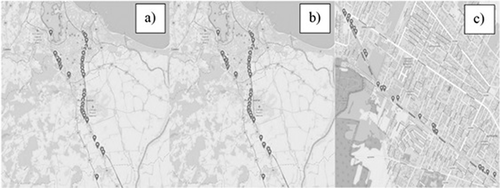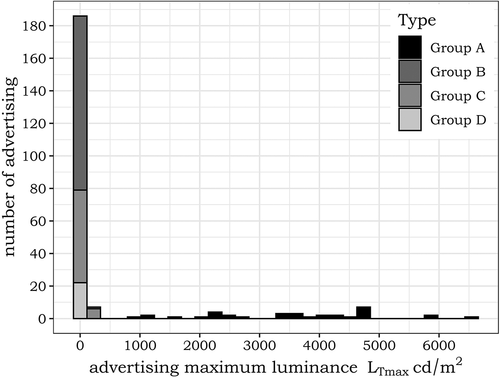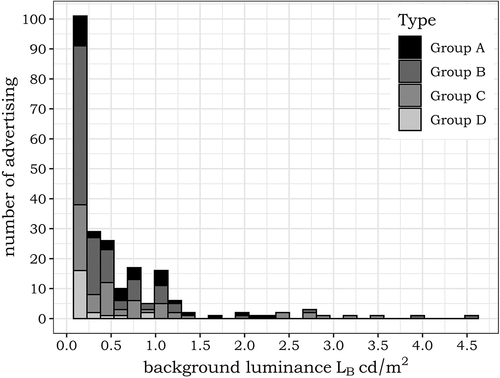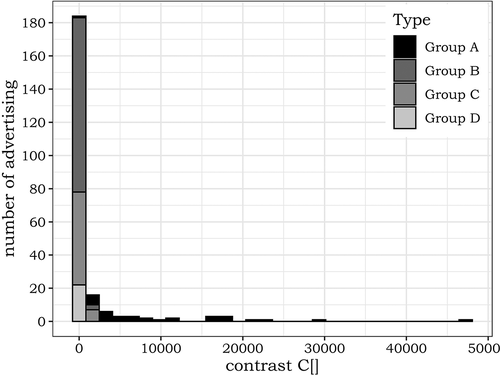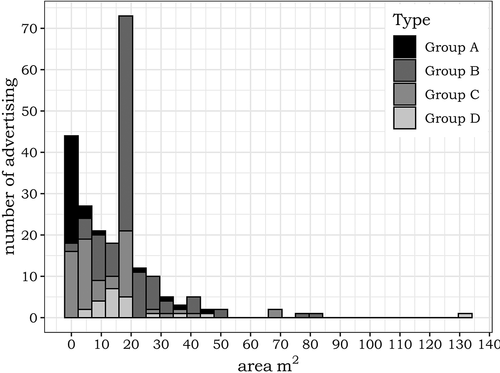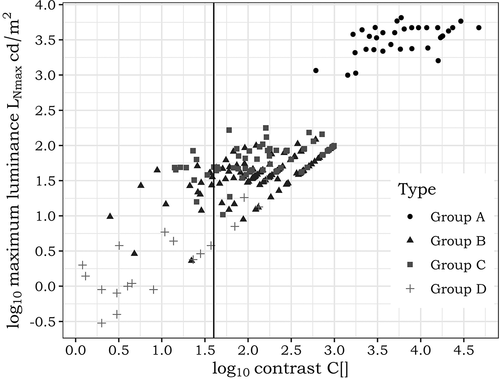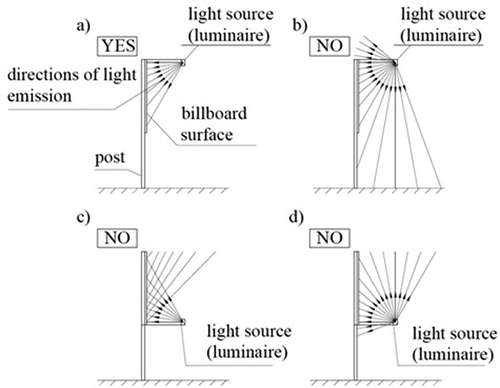 ?Mathematical formulae have been encoded as MathML and are displayed in this HTML version using MathJax in order to improve their display. Uncheck the box to turn MathJax off. This feature requires Javascript. Click on a formula to zoom.
?Mathematical formulae have been encoded as MathML and are displayed in this HTML version using MathJax in order to improve their display. Uncheck the box to turn MathJax off. This feature requires Javascript. Click on a formula to zoom.ABSTRACT
Advertising media installed in the vicinity of the road may pose a potential threat to road safety. The driver’s perception of advertising depends on a number of factors, including the time of day, the location and dimensions of the medium, the luminance value, and the way the light is emitted. However, the excessive or incorrect distribution of media luminance in the driver’s field of vision, especially at night, may have a significant effect on the disturbance of the visual process. The driver’s night vision is generally adapted to low ambient luminance values, illuminated by vehicle and road lighting. Limiting the emission parameters of advertising by means of luminance values is one of the most common legal requirements in many countries, in the context of consent to the location of advertising on roads. For many years now, billboards with unknown emission characteristics and luminance values have been functioning in Poland. Exploitation of advertising media in the vicinity of roads requires the consent of the road manager to install the advertising media, which so far has not required confirmation of the maximum luminance values obtained. This led to the installation of aggressive advertisements on the roads, which disturbed the drivers. In order to determine whether there is a problem of excessive luminance of media in Poland and how high is the percentage of media, pilot studies were carried out on road sections selected by the research team. In the paper have been presented the results of measurements of light parameters (luminance of the carrier, luminance of the background and calculated contrast) and geometric dimensions of the advertising surface, using the original author’s procedure for 227 advertisements located in selected locations in Poland. The obtained measurement results showed that the permissible luminance levels were exceeded many times in the group of advertisements using LED sources. The authors have proposed to introduce a unified, operational procedure for measuring the luminance parameters of advertising media. The undertaken research is aimed at developing guidelines for road infrastructure managers concerning the reduction of brightness of advertisements located in the vicinity of roads.
1. Introduction
According to WHO statistics, road accidents cause many deaths or serious injuries, resulting in 1.35 million deaths worldwide in 2018 (WHO Citation2018). The risk and consequences of collisions are much higher at night due to limited visibility (Boyce Citation2009; Regev et al. Citation2018). There are many different factors influencing the occurrence of road accidents. One of them is the potential distraction of the vehicle driver caused by elements appearing in his field of vision that do not belong to the road infrastructure (e.g. bright advertising media). The aspect of emission parameters of advertising media was the subject of research, which recommended luminance reduction for dynamic advertising (variable content advertising) (Jenkins Citation2016; Kocián et al. Citation2017; Lee et al. Citation2007; Roberts et al. Citation2013; Zalesinska Citation2019). However, the literature does not describe the method of measurement of emission parameters of advertising media, or have presented the results showing their actual values from the position of observation of the media by the driver of the vehicle (Bullough Citation2017; Herrstedt et al. Citation2017; Lewin Citation2008; Roberts et al. Citation2013; Yannis et al. Citation2013; Zhang et al. Citation2017). This lack is glaring due to the widespread use of the emission criterion of luminance in the context of installing advertisements in the vicinity of roads (Anonymous Citation2015; Department of Transport United Arab Emirates Citation2013; Department of Transport and Main Roads Citation2013; SANRAL Citation2000). The impact of advertising on the safety of drivers is a complex issue analyzed in many research works (Oviedo-Trespalacios et al. Citation2019; Zhang et al. Citation2017).
The basic parameter of light emission from the surface of the visual information medium is the luminance of the advertising medium. Luminance LT (described by EquationEquation (1)(1)
(1) , see Section 2.3) (Domke et al. Citation2011; Tomczuk et al. Citation2018a; Tomczuk and Jaskowski Citation2015) expresses the objective expression by the magnitude of the physical luminous intensity of the media surface. The unit of luminance is the candela per square meter of surface area (cd/m2).
During the day, the advertising medium is not usually illuminated. The average luminance of the advertising surface (e.g. with a mean luminance of 2400 cd/m2) is similar to the luminance of its surrounding (background luminance). Sunlight provides high levels of luminance (e.g. 6500 cd/m2) on the advertising surface. The driver in such conditions is adapted to a bright environment, so the emission and geometric parameters of the advertising medium do not have a significant impact on the distraction of the driver’s attention (Carhartt Citation2019) in the context of high luminance values. The situation changes during the night, when the lack of sunlight causes a significant decrease in the luminance of the background on which the advertising medium is observed by the driver. Low luminance levels, e.g. 0.1 to 5 cd/m2, result from the illumination of the roadway with vehicle lights or street lighting, lighting of urban infrastructure, buildings and facades. Such conditions result in a high contrast of luminance between the advertising surface and its background.
The measurement of the luminance of the environment in which the visual media is located is intended to determine the value of the static contrast of the luminance of the surface of the visual media with that of the background. This value is responsible for the perception of the brightness of the object (carrier) by the observer. The darker the environment, in which the medium is located, the more intense the sensations of the observer. It is connected with the adaptation of the observer to night lighting conditions. Excessive luminance contrast in the driver’s field of vision can disturb the driver’s perception of road objects (Fiorentin and Boscaro Citation2019).
The contrast C of the luminance of the advertising surface with the background (Domke et al. Citation2011; Tomczuk et al. Citation2018a; Tomczuk and Jaskowski Citation2015) is the ratio of the luminance difference of the observed object and the background luminance to the background luminance and can be calculated from formula (2) (EN 13201-3 Citation2016) (see Section 2.3).
Most regulations do not specify the value of the permissible luminance contrast. The issue of visual information causing the problem due to contrast was discussed in the guidelines developed for the Department of Transport in the United Arab Emirates (Citation2013). Recommended media luminance contrast is defined as 12:1 or less, with a maximum permissible advertising luminance of 1000 cd/m2. The regulation applies to advertisements illuminated by a front-light. The publication indicates the need to reduce the maximum contrast to 40:1, assuming the medium’s luminance is kept within the range of 250 to 1400 cd/m2 (Luginbuhl et al. Citation2009).
Another aspect of light emission from the surface of advertising media is the issue of limiting the emission of disturbing light, described in the literature of the subject as light pollution. Such light can cause physiological and environmental problems for both the environment and humans (Gaston et al. Citation2012). When light is emitted from advertising media located on roads in residential areas, it is possible to talk about the light that causes discomfort and nuisance to residents, distraction, health problems or deteriorating visual perception of observers, including drivers (Birdsall Citation2008). In the IESNA report (IESNA Citation2000) it is proposed to introduce limits for the value of the lighting intensity parameters generated on the driver’s eye (), depending on the location of the media. In the report, it is recommended to use advertising media with emission parameters not higher than those defined for the E2 area. Using the lighting intensity parameter on the driver’s eyeball when evaluating an advertising medium located in the vicinity of other light sources, including street lighting, may give an ambiguous result.
Table 1. Limit values for driver’s eye illumination (IESNA Citation2000)
The pollution of the environment by the light emitted by advertising media is mainly caused by the emission upward, toward the sky or the emission of light toward the facades of buildings and windows of residential spaces. In order to minimize the effects of the impact, recommendations and legal restrictions on outdoor lighting shall be made to reduce intruder light emissions, based on the requirements in .
Table 2. Lighting requirements for intrusive outdoor lighting installations (IESNA Citation2000)
In many countries, attempts have been made to reduce light emission from advertising media in the context of the negative impact of electronic advertising (IESNA Citation2000; Johnson Citation2009; Road Safety Committee Citation2006). So far, no uniform requirements, guidelines or international standards have been established for this type of advertising. In many countries there are local recommendations or regulations, e.g. in Australia (Department of Transport and Main Roads Citation2013; Department of Transport and Main Roads Citation2019; Roberts et al. Citation2013; Transportation Environment Consultants Citation1989), United Arab Emirates (Department of Transport United Arab Emirates Citation2013), Great Britain (Departament for Communities and Local Government Citation2007; TfL Citation2013), New Zealand (Jackett and Frith Citation2013), South Africa (SANRAL Citation2000), and selected states of the USA (Anonymous Citation2007; Lighting Research Center Citation2008; Michon Citation1985; New York State Department of Transportation Citation2008; St. Croix County Planning and Zoning Department Citation2007). For example, in England, the value of maximum luminance depends on the area of the advertising medium (TfL Citation2013). For media with an area of more than 10 m2 it is 300 cd/m2, whereas for smaller media it is 600 cd/m2. Similar guidelines apply to South Africa, which is summarized in more detail in .
Table 3. Luminance levels for RPA (SANRAL Citation2000)
With respect to the impact of light from electronic media (e.g. LED televisions), it should be noted that existing legislation indicates the need to limit the possibility of displaying moving images, as well as to keep a minimum advertising display time, duration of visual effects and interval between consecutive images. For such (electronic) media, it is necessary to simultaneously limit the maximum luminance of the advertising medium.
The literature has not yet described a uniform method of measuring the fast-changing value of advertising luminance under field conditions. In Poland, advanced research was carried out in the field of dynamic media testing (Chrzanowicz and Tomczuk Citation2017; Chrzanowicz et al. Citation2017; Wandachowicz et al. Citation2011), and regulations limiting light emission from dynamic advertising media were introduced (Anonymous Citation2015). According to the provisions of the Act in force in Poland, light advertising placed near a road in a built-up area cannot emit more than 4000 cd/m2 of light during the day and 600 cd/m2 at night. Outside built-up areas, advertisements may not emit more than 4000 cd/m2 during the day or 400 cd/m2 at night. The maximum luminance values for advertising media proposed in the proposed regulation significantly reduce the brightness of the advertisements. The technical parameters of modern RGB LED matrices used in the construction of media screens for advertising allow high luminance of the broadcasting surface (often above 10000 cd/m2) to be achieved. According to the draft regulation, this luminance should not be changed at a rate faster than 200 cd/m2 per second. This means that advertisements will not be able to change luminance levels so quickly, especially at night, where they could potentially disturb the driver’s vision.
So far, no studies have been carried out in Poland on a large number of advertising panels, with respect to the measurement of the luminance of an advertisement and the background in which the advertisement is placed in real road conditions. Moreover, the operational procedure of measuring the luminance parameter has not been formulated so far and the technical parameters of the measurement equipment used for this purpose have not been indicated. This article presents the author’s procedure of measuring the luminance of an advertising medium located in the vicinity of the road and includes preliminary results of tests carried out on a sample of 227 advertising media.
2. Method
2.1. Purpose and objects of research
The main aim of the research discussed in this paper is to analyze the results of luminance measurements made on a large number of advertising media and to examine the relationships between lighting and geometric parameters. The effect of the measurements is to indicate advertisements that exceed the adopted technical parameters and may potentially cause interference with the driver’s vision process.
The paper presents the results of measurements of luminance parameters and geometric dimensions of advertising media situated near the roads of different classes. The research on the level of luminance of advertisements was carried out on roads managed by the General Directorate for National Roads and Motorways, co-financing the research in the project (Tarnowski et al. Citation2019). The measurements were carried out in Poland in three locations, : a) Gdańsk – Tczew – Gdańsk (68.8 km, Road No. 91, A1, S6 – 122 advertisements), b) Warsaw – Marki (6.85 km, Road No E67, 629, S8 (DK 8)). 63 carriers, c) Łomianki – Warsaw (7.8 km, National Road No. 7 – 44 carriers). In total, 227 advertisements were examined on 83.45 km of roads (the average density of media distribution was 2.7 advertisements per km, in built-up areas 13.3 advertisements per km). The analysis of the density of advertising media on individual road sections is not the subject of this study. The measurements were carried out for media permanently connected with the ground or fixed in a permanent way, e.g. to the elevation of the building. The measurements were carried out with the use of the original, author’s procedure referring to the regulations in force in Poland and extending their requirements for carrying out luminance measurements in field conditions.
2.2. Definition and breakdown of advertising
For the purpose of this article, the definition of advertising has been adopted: “Advertising means a billboard or advertising device placed in the field of view of the road user, as well as any other visual information carrier, including its structural elements and fixtures, which is not a road sign.”
These advertisements may be categorized according to the following criteria: geometrical dimensions, emission characteristics, legibility of content, content of visual information, means of communication, form of communication, foundation of advertising media, and location of media in the field of vision of the driver of the vehicle. This publication focuses on the analysis of emission parameters. The research carried out by the authors was an element of interdisciplinary research on other issues, also related to the reception of advertising message content (Harasimczuk et al. Citation2018; Mackun et al. Citation2017, Citation2018; Olejniczak-Serowiec et al. Citation2017; Targosiński Citation2017; Tarnowski et al. Citation2017). For the purpose of the presented research and implementation of future recommendations, due to the way of light emission, the division of advertisements into four groups was applied ():
Fig. 2. Advertisements types (group A top left, group B top right, group C bottom left, group D bottom right). Source: Own description
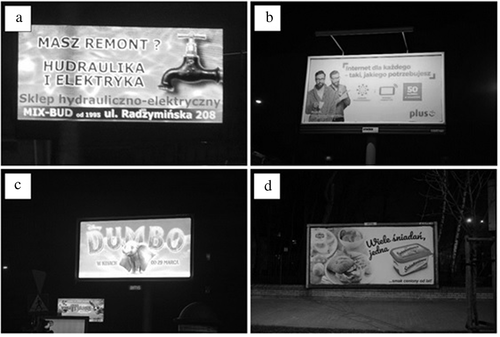
Group A – advertisements in which the emission plane is at the same time a source of light. These are advertisements equipped with light sources using most often single or multicolor semiconductor diodes, as well as neon lights. This group also includes TV screens, TV and computer monitors, projectors, projectors, solutions using LED, OLED, laser and other light sources.
Group B – advertisements in which the emission plane is illuminated by means of light sources (luminaires), installed from the front (front-light).
Group C – advertisements in which the emission plane is semi-permeable and the light source is located behind it back-light.
Group D – advertisements in which the emission plane is intentionally not illuminated. It is a case of using street lighting, foreign light coming from the advertising environment, car vehicle lighting or lack of any artificial lighting (reflective materials).
2.3. Identification of parameters of advertising media
In order to unify the parameters measured during the field research, the following features were assigned to the advertising medium ( and 5):
luminance of the surface of the advertising medium LT,
luminance of the advertising medium environment LB,
classification according to the division concerning the way of light emission, division into four groups (),
geometrical dimensions, foundation height and distance from the edge of the roadway (),
angle of setting the advertisement in relation to the axis of the roadway Θ,
measuring distance d.
Fig. 3. Measurement geometry for billboard luminance (Chrzanowicz and Tomczuk Citation2017; Chrzanowicz et al. Citation2017)
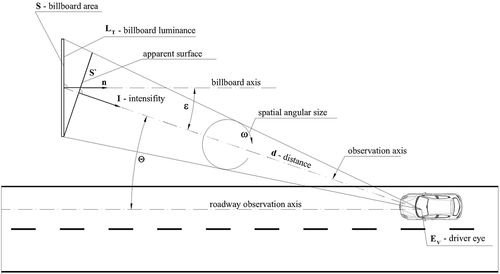
The basic parameter of light emission from the surface of a visual information carrier is the luminance of the advertising carrier. The luminance of LT advertisement (described in EquationEquation (1))(1)
(1) expresses the physical intensity of the light of the surface of the medium. The unit of luminance is the candela per square meter of surface area S (cd/m2), as shown in .
If the dS surface is a source of radiation with a luminous intensity of dI, then (Chrzanowicz and Tomczuk Citation2017; Chrzanowicz et al. Citation2017):
where:
dI – the light emitted from the surface of the advertising medium in the direction of observation (cd),
dS – the cross-sectional area of the radiation beam containing this point (m2),
ε – the angle between the observation axis and the billboard axis.
The measured luminance value on the media surface is differentiated. Its value depends mainly on the exposed content and the way the light is emitted. After measuring the luminance of an advertisement emitting light, the following parameters of the advertising medium surface area should be determined: minimum luminance LTmin (cd/m2), maximum luminance LTmax (cd/m2), average luminance LTave (cd/m2). The maximum LTmax luminance value (cd/m2), which describes the physical properties of the light-emitting surface in the direction of the observer – driver, should be used to identify the limit values present in the media.
In addition to the luminance parameter of the advertising medium itself, the luminance of the background in which the advertisement is placed, i.e. the luminance of the advertising environment, should be measured. The following parameters can be used to determine the brightness of the advertising medium environment: minimum background luminance LBmin (cd/m2), maximum background luminance LBmax (cd/m2), and the target value of the average background luminance LBave (cd/m2).
Measurement of the luminance of the advertising environment (the background in which the advertisement is placed) is necessary to determine the value of the static luminance contrast C. This parameter determines the luminous impression of the advertisement observed by the observer (driver). The darker the environment in which the emission medium is located, the more intense are the visual impressions of the observer. It is also indirectly connected with the adaptation of the observer (driver) to the prevailing night lighting conditions. Excessive luminance contrast in the driver’s field of vision can interfere with his visual perception (Domke et al. Citation2011; Fiorentin and Boscaro Citation2019). The luminance contrast C is the ratio of the difference between the luminance of the observed object (maximum luminance of the advertising medium) and the average luminance of the background, related to the average luminance value of the background and can be calculated according to the formula (2) (EN 13201-3 Citation2016):
where:
C – the luminance contrast,
– maximal value of the luminance of the advertising medium (cd/m2),
– the mean value of the ambient background luminance of the advertising medium (cd/m2).
2.4. Measuring procedure
An important issue is the correct determination of the values of emission parameters (especially the maximum luminance of the advertisement) for the tested advertising media. It is connected with the necessity of carrying out in field conditions a number of specialized measurements of particular lighting and geometric parameters while maintaining uniform rules of conduct. Performing the measurements with the use of the author’s own procedure will unify the operational approach to the measurements of advertising media located in the vicinity of roads. This will allow for comparisons, analysis of results, and drawing conclusions. In order to carry out the tests, the following measurement procedure was applied:
The measurements should be carried out with the use of calibrated luminance meters.
The measurement of luminance should be performed with a meter with the smallest possible measuring field (≤1°, recommended 0.1°, ) or with a matrix meter.
The determination of maximum luminance cannot be achieved by indirect methods (e.g. by means of a light intensity meter with luminance measurement attachments).
The maximum luminance value shall be measured in the areas with the highest possible luminance (the area with the highest brightness) present on the carrier.
The measurement of luminance for LEDs and media with variable content shall be carried out for a static image displayed with maximum emission parameters.
The geometrical parameters of the advertising medium (dimensions of the medium) as well as the distances and angles of the carrier’s foundation in relation to the roadway should be determined.
The maximum luminance value should be determined for a static image, examining the surface of the carrier perpendicular to the geometric axis of the advertising medium from the edge of the roadway.
The measurement shall be carried out after a minimum of 100 hours of operation of the light source used to produce the emission from the advertising medium or its lighting or backlighting.
The tested medium must have the lighting switched on at least 30 minutes before the start of the measurements.
In the case of media with adjustable backlight levels, its parameters should reach the maximum possible values after the assumed time, e.g. 30 minutes. If necessary, the time should be extended to 1 h.
The measurement should be carried out in good atmospheric conditions (good air transparency, no precipitation, no fogging or phenomena that could change the measurement results).
The temperature during the measurement should be within the permissible operating range of the used measuring instruments (e.g. dew point preserved).
Determination of the minimum size of the measuring field of the meter is to ensure high accuracy of searching for the maximum luminance value. Too large measuring field will cause averaging of the value on the measured surface, which may result in a significant understatement of the parameter of maximum luminance of the advertising medium.
The measuring field of the meter must be within the measured area ().
The measuring field of the meter must not be larger than 1/10 of the maximum media dimension.
If the measuring field does not lie within the measurement area, the measurement distance should be reduced (parameter d, ), adjusting it to the available angular size of the measurement field of the meter.
The angular size of the measuring field provided by a luminance meter defines the maximum distance from which luminance measurements can be made on the surface of the media. The smaller the angular size of the measuring field available in the meter, the greater the maximum distance from which the measurement can be made.
The height of the luminance meter head mounting from the road surface should be 1.5 m (the value corresponding to the typical height of the driver’s eye location in a motor vehicle) (CIE Citation2017; EN 13201-3 Citation2016) ().
The highest probability of the maximum luminance value is in the perpendicular position of the meter in relation to the advertising emission surface (. case a and b). It is recommended to take measurements from the direction perpendicular to the advertisement – from the edge of the roadway (unless there is a suspicion of an unusual way of light beam emission by the medium – . case c). The construction of modern light sources and optical systems (e.g. LEDs equipped with asymmetrical optics) allows to obtain very unusual light distributions. From here, all possible directions of light beam emission emitted from the carrier to the road users should be checked.
In case of justified doubts concerning the main direction of light beam emission from the advertising medium, the measurement should be made from different angles of observation of the advertising medium observed from the road.
Fig. 4. Example of the measurement of the maximal luminance of a billboard with a 0.1° measuring field angle. Source: Own description
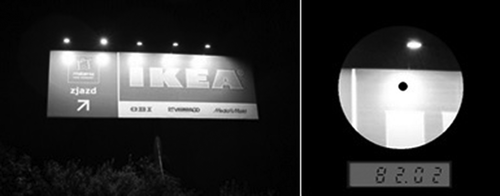
Fig. 5. Measurement fields of LT advertising luminance and LB background luminance as well as the location of the meter. Source: Own description

Fig. 6. Potential directions of medium observation and measurement (arrow length represents light value), a) the highest emission in the axis perpendicular to the medium, b) uniform and symmetrical emission, c) asymmetrical emission. Source: Own description

For the luminance measurements included in this article, a point luminance meter with a variable measuring field from 6' (Konica Minolta CS-200 luminance meter was used) has been used. For reasons of road traffic measurements and the need to maintain the safety of people taking part in them, the measurements were taken from the edge of the road, and not from the location of the eye of the driver of the vehicle. The measuring instrument (luminance meter) was set at a height of 1.5 m above the road surface.
3. Results and discussion
The results of measurements were made and recorded for a total of 227 advertising panels () located along roads in three locations in . All advertisement research was conducted in the month of September at night between 23:00 and 4:00. In terms of the type of advertisement, measurements were made for: 34 advertisements from group A, 108 from group B, 63 from group C and 22 from group D. presents average values of parameters for all advertising groups: maximum media luminance (LTmax), media area and media contrast (C) with its background. The standard deviation of the scattering width of the measured values in relation to the calculated mean values is given. Additionally, the mean luminance value of the advertising medium background was determined (mean LBave). On the basis of the maximum luminance of the advertising medium and the determined mean luminance of the background, the contrast was calculated according to the formula (2).
Table 4. Results of the measurements of lighting parameters of advertising media
Group A ads are characterized by the highest values of maximum luminance (): 15 ads (44%, n = 34) have a maximum luminance value in the range of 4000 to 7000 cd/m2, and 19 media (56%, n = 34) have a value in the range of 1000 to 4000 cd/m2. For group B, 106 media (98%, n = 108) and 56 in group C (89%, n = 63) have the maximum luminance value in the range 0 to 100 cd/m2, while two advertisements in group B (2%, n = 108) and seven in group C (11%, n = 63) have the values in the range 100 to 200 cd/m2. Advertisements in group D, characterized by lack of dedicated lighting, have maximum luminance similar to the background luminance and are in the range of 0.1 to 4.5 cd/m2 (78%, n = 22) with five exceptions, for which the value of 35 cd/m2 is not exceeded (22%, n = 22).
Background luminance depends on the location of the advertising medium and the immediate surroundings of the advertisement. In case of 83% (n = 227) of the media does not exceed 1 cd/m2, and in other cases the maximum value is 1 to 4.5 cd/m2 (17%, n = 227) ().
The luminance contrast values refer to the maximum luminance of the advertising medium and the average luminance of the background – the place where the advertisement is located (). The obtained results are characterized by high variability, and in the case of group A the results are in the range of 611 to 47255. For group B the contrast value is in the range of 2.5 to 964, similar range is in group C 14 to 902, while for group D it is 1.2 to 165.
The surface area of advertising media is varied, often dictated by the availability of space on buildings or limited by other infrastructure in a given location (). The most common are advertisements with a small area not exceeding 5 m2 (27%, n = 227). The most popular format is a traditional billboard with dimensions of 3 m x 6 m or 4 m x 6 m (38%, n = 227).
Advertisements belonging to group A (e.g. LED, Telebim) are characterized by the highest values of maximum luminance and contrast. If the obtained results are compared with the formal requirements in force in South Africa (The South African National Roads Agency Citation2000), limiting the maximum allowed luminance from the advertising surface () or the proposal of Polish regulations (600 cd/m2), it should be noted that in group A, there are no media meeting these limits. However, advertisements from other groups meet the above criteria. In the case of group A advertisements, the use of LED technology may help to control the brightness of the advertisement through the use of built-in controls. It is, therefore, necessary that this type of advertising be supervised by the owner of the advertisement at the request of the road manager.
Fig. 11. The values adopted in South Africa (SANRAL Citation2000) limiting the maximum allowed luminance on the advertising surface with marked limitations according to . The broken line indicates the luminance limitations for day and night time in Poland. Source: Own description
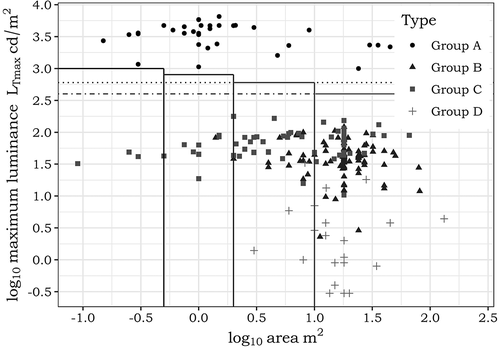
The obtained research material shows that the most negative impact on the driver, in terms of the possibility of inducing the glare process, is generated by advertisements in groups A and C. They also cause the greatest contrast. In the case of contrast, there is no clear value that can be accepted as dangerous. In relation to Luginbuhl’s 40:1 value, only 44 advertisements meet this criterion (19%, n = 227) () (Luginbuhl et al. Citation2009). It may happen that despite the high luminance values of the surface and contrast, the advertisement will have little impact due to the small area and small angular size. It is also possible to reverse situations (low luminance and contrast, but large surfaces and angular sizes, e.g. group B), which may be underestimated by scientists (Snowden et al. Citation2012) and thus become a threat to traffic in difficult weather conditions (Jägerbrand and Sjöbergh Citation2016) and in glare conditions (Aguirre et al. Citation2008; Kent and Fotios Citation2019). This problem is not fully recognized and should be further investigated.
4. Preliminary proposal for practical recommendations
The results of the luminance measurements obtained show that there are no grounds to classify all advertisements placed in the driver’s field of vision as potentially dangerous for the driver and thus for road traffic. However, there are examples of advertising media which, because of their high emission values, incorrect location of the advertisement or incorrectly installed luminaires illuminating the advertising surface, may potentially affect the visual task of the driver and contribute to a decrease in road safety.
Advertising occurs in the vicinity of roads, in areas with different lighting conditions. These zones can be assigned to general lighting levels. Five zones can be distinguished (), which have been defined as described in the recommendations (CIE Citation2017; ILP Citation2015).
Table 5. Lighting zones (CIE Citation2017; ILP Citation2015)
On the basis of the existing regulations (CIE Citation2017; ILP Citation2015), the team developed preliminary operational recommendations for the installation of advertisements in the vicinity of roads (driver’s field of vision), aimed at neutralizing these factors, which may have a negative impact on road traffic safety. In this paper, we focused on the lighting parameters, for which a number of recommendations related to particular groups of advertising media were specified.
For advertising in groups A, B and C, it is recognized that advertising should not:
have a light source or lighting fitting output visible to the driver’s eye and observed from any direction on the road,
emit light varying in time and space (variable luminous intensity, variable mode of signal transmission, variable color, moving light source or beam, flashing, pulsing, rippling, etc.),
have a damaged (dimmed or blinking) light source for backlighting (group A and B) or media overexposure (group C). In the event of a failure of one of the multiple sources, the other light sources should be switched off until the failure is rectified, emit light toward the sky in order to eliminate light pollution (),
depending on the area in which the advertising medium is located, exceed the maximum luminance limits of the medium () (CIE Citation2017; ILP Citation2015),
within a single advertisement combine the features of lighting groups A, B, C and D (e.g. the advertisement cannot be illuminated and simultaneously emit light from all or part of the surface or, e.g. be underexposed and emit light from part of the advertising surface),
exceed maximum luminance 5000 cd/m2 during the day. The recommendation formulated for the daytime is based on publications (CIE Citation2017; ILP Citation2015).
Table 6. The level of luminance depends on the surface of advertising medium (CIE Citation2017; ILP Citation2015)
For advertisements in groups A, B and C, the advertisement should:
have a coordinated work program: the dimming time of the advertising medium in the relation day – night – day should be correlated with the time of switching on and off the street lighting installation taking into account corrections related to the latitude and longitude of the foundation of the advertising medium. The emission level can be controlled by an external lighting sensor including an astronomical clock,
emit light with the least possible impact on the environment of the medium and upward. Where the surface of the media is illuminated by external luminaires, they should be directed only at the surface of the advertising medium (). To reduce the effect of sky light pollution, front light (group B) media luminaires should be installed on top of the media and the light should be directed downward toward the illuminated surface. At the same time, specialist luminaires should be used that are equipped with screens for light (e.g. blinds, shields and partitions), limiting light emission in a direction other than the illuminated surface of the advertising medium.
Additional guidance has also been formulated. It is recommended that:
advertising which emits light is dimmed at night,
the advertisement was made in back-light technology, i.e. backlighting from the back (inside),
the luminaires illuminating the advertisement were equipped with a system of diaphragms completely limiting the emission of light upwards and in other undesirable directions.
Additional requirements were defined for advertisements where the emission plane is at the same time a light source (group A). For this group of media it is required that:
in the case of media allowing the presentation of variable content, the minimum display time of one advertisement exposure was 30 seconds and the transition between the images must take place immediately (according to the authors, 10 seconds given by Domke (2011) is too short a time to reach the advertisement),
due to the change of the 24h period, the change of the luminance level should be gradual by not more than 200 cd/m2 per minute (Anonymous Citation2015),
emission advertising was excluded at the request of the road manager,
stops emitting light when it is not needed, e.g. during the day and after the agreed time.
Further restrictions are indicated, i.e. advertising should not:
use effects (e.g. penetration, flow, abrasion, etc.) when switching between static images,
display sequential images of a common message one after the other,
present on a carrier animations, films and moving images,
have an area of more than 100 m2,
cause glare by sudden change in luminance values (increase or decrease in luminance of the surface of the visual information placed on the light-emitting advertisement),
interfere with and influence the operation of traffic monitoring and control equipment (e.g. video detectors or cameras) and road and city monitoring.
Additional information is also specified. We recommend that you advertise:
the advertising medium should be equipped with a photoelement and a regulator (controller) in order to automatically adjust the luminance to the level of external lighting. If, during the day, the conditions of brightness of the advertising medium environment change significantly (e.g. intensive snowfall, rainfall), the luminance of the medium surface should be reduced to the value corresponding to the night-time,
it is equipped with a driver enabling remote control of the advertising medium lighting,
it is equipped with a technology for stopping the displayed images in the event of failure of the device, in particular with regard to dynamic advertising (e.g. LED media and LED wall screens),
the device is protected against displaying images whose luminance exceeds the limit value expressed in cd/m2 and has security features which make it impossible to change this limit value in the future, in particular, it concerns dynamic advertisements (e.g. LED carriers and LED screens).
5. Conclusion
The article has been presented the author’s procedure of measuring the parameters of luminance of advertising media placed in the vicinity of roads. The proposed operational measurement procedure was applied during pilot field studies. The authors have measured 227 advertisements in three locations in Poland. The procedure allows to identify the maximum luminance value of the advertising medium and to assess the influence of the medium on the environment by taking into account the luminance of the environment and consequently to calculate the luminance contrast. As a result of the measurements, the media that exceed the limit values and may pose a potential threat to the drivers were identified.
The division of advertising media into four basic groups related to the emission of light from the advertising surface within the applied procedure (A, B, C, D), adopted for the purposes of the research, reflects the achieved emission parameters of advertising media and allows to formulate requirements for each group individually.
The tested advertising media from groups B, C and D () did not exceed 200 cd/m2 for the maximum luminance parameter. In the case of type A media, static and dynamic media were taken into account, which significantly exceeded these values. The assumptions of the Landscape Act adopted in Poland (Anonymous Citation2015) indicate that the maximum luminance at night cannot exceed 600 cd/m2 in a built-up area and 400 cd/m2 outside a built-up area. Therefore, the media from group A () did not meet these values. Despite the relatively low level of brightness of media from groups B, C and D, some of them may have a negative impact on the driver. This is due to the fact that the advertisement is located in a dark environment which creates a high contrast between the luminance of the advertisement and the background. The analysis of the research results showed unequivocally that there are situations in which the permissible luminance levels assumed in the landscape law in Poland are too high.
Summarizing the results of the research, it can be stated that:
the most disturbing in terms of the luminance values produced is group A Televisions based on semiconductor LED light sources produce many times higher (in comparison to other groups) values of maximum luminance. The effect of the interaction is intensified by the setting of the medium in a dark environment (high contrast). In combination with the large size of the medium, the light impressions perceived by observers are very strong and negative,
negative effects of group A advertisements with high luminance levels are multiplied in the case of dynamic variable content media (change of sequence with transition through dark background). The A group A advertising medium, e.g. a screen, can quickly change the luminance level (Tomczuk et al. Citation2018b) of the surface, which can lead to the driver’s excessive focus on the traffic situation (Mackun et al. Citation2018). The issue may be the subject of further research work,
group C advertising enables technically high levels of luminance to be achieved and should, therefore, be systematically controlled (with group A). Due to the backlighting method, the luminance of the surface is uniform on this type of medium, which improves the readability of the presented content,
The brightness of the medium should be adjusted to the luminance of the environment in which it is placed. This affects the value of the created luminance contrast.
The authors of the article formulated general recommendations concerning light emission from the advertising surface. They may be the basis for the introduction of legal restrictions concerning light emission from the advertising medium. The recommendations proposed by the authors refer to technical solutions of advertisements placed in the vicinity of Polish roads.
The developed recommendations for advertising for the General Directorate for National Roads and Motorways (main roads) can be used on local roads (e.g. street in small towns and villages) (Anonymous Citation2018).
When conducting advertising campaigns, advertising companies often use the same advertising medium (content, appearance, surface, luminance) in different locations with different luminance of the environment. It leads to the creation of different luminance contrast values. Therefore, each of the advertising media should be treated individually in terms of the impact of light on the environment. The decision on its location in the vicinity of the road should be preceded by measurements of the luminance of the existing medium and the future environment. Thanks to the use of the luminance contrast parameter it is possible to determine the influence of the medium in the proposed location, where it is enough to measure the ambient luminance in the place of the planned foundation of the future advertising medium.
The issues discussed in the article do not describe the whole spectrum of issues related to the impact of advertising media in the vicinity of roads on the driver. In addition to the aspects of light emission on the analyzed measuring sections, drivers were tested with the eye tracker. They showed the existence of the problem of long advertising observation times, even above 5 seconds. This may distract the driver from the road situation and cause a traffic hazard. Locational and content aspects will be further researched and published (Mackun et al. Citation2017, Citation2018; Tarnowski et al. Citation2019).
Acknowledgements
Issues presented in this article have been the subject of research and analysis in the project carried out in the period from 01.01.2016 to 30.06.2018 by the Faculty of Transport of the Warsaw University of Technology entitled: The influence of advertisements on the level of road safety, contract number: DZP/RID-I-33/4/NCBR/2016 (Development of Road Innovation), financed by the National Centre for Research and Development and the General Directorate for National Roads and Motorways. The present article is not financed from this project and other sources.
Disclosure statement
The authors have no financial interests to declare.
Additional information
Funding
References
- Aguirre RC, Colombo EM, Barraza JF. 2008. Effect of glare on simple reaction time. J Opt Soc Am A Opt Image Sci Vis. 25(7):1790–1798. doi:https://doi.org/10.1364/josaa.25.001790. PMID: 18594637.
- [Anonymous]. 2007. Amending chapter 28 of the city code of San Antonio, Texas, by adding provisions for digital signs. An ordinance: 2007-12-06-1247, NH/TM: 10/18/2007 [accessed 2020 May 10]. https://library.municode.com/tx/san_antonio/codes/code_of_ordinances?nodeId=PTIICO_CH28SI.
- [Anonymous]. 2015. The act of 24 April 2015 amending certain acts in connection with the strengthening of landscape protection tools. Polish Journal of Laws 2015 item 774 [accessed 2020 May 10]. http://prawo.sejm.gov.pl/isap.nsf/download.xsp/WDU20150000774/O/D20150774.pdf.
- [Anonymous]. 2018. ZAŁĄCZNIK NR 5 DO RAPORTU KOŃCOWEGO ZADANIE 5 Wytyczne do oceny wpływu reklam zewnętrznych na bezpieczeństwo ruchu drogowego. Wynik z osiągniętego etapu pracy nad Projektem pt. “Wpływ reklam na poziom bezpieczeństwa ruchu drogowego” będącym przedmiotem umowy nr DZP/RID-I-33/4/NCBR/2016. OT3-3D/ITS-UW-PG-PW. https://www.gddkia.gov.pl/frontend/web/userfiles/articles/w/wytyczne-do-oceny-wplywu-reklam-_35115/za%C5%82%C4%85cznik%20nr%205%20RID%2033.pdf.
- Birdsall MS. 2008. The debate over digital billboards: can new technology inform drivers without distracting them? Inst Trans Eng ITE J. 78(4):22.
- Boyce PR. 2009. Lighting for driving: roads, vehicles, signs, and signals. Boca Raton (FL): Taylor and Francis Group.
- Bullough JD. 2017. Factors affecting sign visibility, conspicuity and legibility: review and annotated bibliography. Interdiscip J Signage Wayfinding. 1(2):2–25.
- Carhartt D. 2019. Illinois coalition for responsible outdoor lighting. [accessed 2020 May 10]. http://www.illinoislighting.billboards.html.
- [CEN] European Committee for Standardization. 2016. EN 13201-3: 2016-03Road lighting – part 3: Calculation of performance.
- Chrzanowicz M, Tomczuk P. 2017. Research on the parameters of light emitting advertising media. MATEC Web Conf. 122:03002.
- Chrzanowicz M, Tomczuk P, Jaskowski P. 2017. Methods for measuring the surface of a light-emitting advertising medium. Warsaw Univ Technol Res Pap. 118:49–60.
- [CIE] International Commission on Illumination. 2017. Guide on the limitation of the effects of obtrusive light from outdoor lighting installations. 2nd ed. doi:https://doi.org/10.25039/TR.150.2017.
- Departament for Communities and Local Goverment. 2007. Town and country planning (control of advertisements) (England) regulations 2007. [accessed 2020 May 10]. https://assets.publishing.service.gov.uk/government/uploads/system/uploads/attachment_data/file/7678/321506.pdf.
- Department of Transport and Main Roads. 2019. The roadside advertising manual Edition 3. Government Queensland [accessed 2020 May 10]. https://www.tmr.qld.gov.au/-/media/busind/techstdpubs/Traffic-management/Roadside-advertising-manual/Roadside-Advertising-Manual—Technical-Volume.pdf?la=en.
- Department of Transport United Arab Emirates. 2013. Roadside advertising manual. Document No: AD-R-03. 1st ed. Abu Dhabi (United Arab Emirates): Department of Transport.
- Domke K, Wandachowicz K, Zalesinska M, Mroczkowska S, Skrzypczak P. 2011. Digital billboards and road safety. Light Eng Archit Environ. 87:119–131.
- Fiorentin P, Boscaro F. 2019. A method for measuring the light output of video advertising reproduced by LED billboards. Measurement. 138:25–33.
- Gaston KJ, Davies TW, Bennie J, Hopkins J. 2012. Reducing the ecological consequences of night-time light pollution: options and developments. J Appl Ecol. 49:1256–1266.
- Harasimczuk J, Maliszewski NE, Olejniczak-Serowiec A, Tarnowski A. 2018. Are longer advertising slogans more dangerous? The influence of the length of ad slogans on drivers’ attention and motor behavior. Curr Psychol. doi:https://doi.org/10.1007/s12144-018-9955-y
- Herrstedt L, Greibe P, Andersson P, La Cour Lund B. 2017. Do LED-advertising signs affect driver attention? Paper presented at the 5th International Driver Distraction and Innatention (DDI) Conference; Paris, France.
- [IESNA] Illuminating Engineering Society of North America. 2000. Light trespass: research, results and recommendations. IESNA Publication no. TM-11-00. New York (NY): IES.
- [ILP] The Institution of Lighting Professionals. 2015. The brightness of illuminated advertisements. Institution of Lighting Professionals [accessed 2020 May 10]. https://www.rbkc.gov.uk/idoxWAM/doc/Other-2288163.pdf?extension=.pdf&id=2288163&location=Volume2&contentType=application/pdf&pageCount=1.
- Jackett M, Frith W. 2013. Quantifying the impact of road lighting on road safety – a New Zealand study. IATSS Res. 36:139–145.
- Jägerbrand AK, Sjöbergh J. 2016. Effects of weather conditions, light conditions, and road lighting on vehicle speed. SpringerPlus. 5:505.
- Jenkins S. 2016. Recommendations for the maximum luminance of digital advertising signs. Queensland (Australia): Government Queensland Department of Transport and Main Roads.
- Johnson C. 2009. Outdoor advertising sign regulation study. Washington (DC): National Highway Cooperative Research Program, Transportation Research Board. Report No. NCHRP 20-07 (Task 247).
- Kent MG, Fotios S. 2019. The effect of a pre-trial range demonstration on subjective evaluations using category rating of discomfort due to glare. LEUKOS. 1–16. doi:https://doi.org/10.1080/15502724.2019.1631177
- Kocián K, Kocourek J, Nouzovský L, Radová Z, Svatý Z. 2017. Impact of roadside advertising on road safety in the Czech Republic. Paper presented at the Smart City Symposium Prague (SCSP); Prague (Czech Republic).
- Lee SE, McElheny MJ, Gibbons R. 2007. Driving performance and digital billboards. Blacksburg: Virginia Tech Transportation Institute.
- Lewin I. 2008. Digital billboard recommendations and comparisons to conventional billboards. Scottsdale (AZ): Lighting Sciences, Inc.
- Lighting Research Center, Rensselaer Polytechnic Institute, (RPI). 2008. Technical memorandum: evaluation of billboard sign luminances. New York (NY): Department of Transportation. Prepared for New York State.
- Luginbuhl CB, Walker CE, Wainscoat RJ. 2009. Lighting and astronomy. Physics Today, 62(12):3–37. doi:https://doi.org/10.1063/1.3273014
- Mackun T, Żukowska J. 2017. The safety issue of roadside advertising – comparison of polish and abu dhabi regulations. MATEC Web Conf. 122:03005.
- Mackun T, Żukowska J, Romanowska A. 2018. Analysis of the relationship between the length of eye fixation and the parameters of advertisements visible from the road. MATEC Web Conf. 231:04007.
- Michon JA. 1985. A critical review of driver behaviour models: what do we know, what should we do? In: Evans L, Schwinn RC, editors. Human behavior and traffic safety. New York (NY): Plenum Press; p. 485–520.
- [NYSDOT] New York State Department of Transportation. 2008. Criteria for regulating off-premise changeable electronic variable message sings (CEVMS) in New York State –draft. [accessed 2020 May 10]. https://www.dot.ny.gov/divisions/engineering/real-estate/repository/cevms-criteria-for-website.pdf.
- Olejniczak-Serowiec A, Maliszewski N, Ziętek K. 2017. Social attitudes towards roadside advertising. Paper presented at the MATEC Web of Conferences; Hualian, Taiwan.
- Oviedo-Trespalacios O, Truelove V, Watson B, Hinton JA. 2019. The impact of road advertising signs on driver behavior and implications for road safety: A critical systematic review. Transp Res Part A. 122:85–98.
- Regev S, Rolison JJ, Moutari S. 2018. Crash risk by driver age, gender, and time of day using a new exposure methodology. J Safety Res. 66:131–140.
- Road Safety Committee. 2006. Inquiry into driver distraction. Australia: Parliament of Victoria [accessed 2020 May 10]. https://www.parliament.vic.gov.au/images/stories/committees/rsc/driver_distraction/Distraction_Final_Report1.pdf.
- Roberts P, Boddington K, Rodwell L. 2013. AP-R420-13 AUSTROADS RESEARCH REPORT Impact of Roadside Advertising on Road Safety. Outdoor Media Association (OMA), Sydney, Australia.
- [SANRAL] The South African National Roads Agency Limitedand National. 2000. Regulations on advertising on or visible from national roads R.1402/2000. Government Gazette No 21924.
- Snowden R, Thompson P, Trościanko T. 2012. Basic vision - an introduction to visual perception. Rev ed. Oxford (UK): Oxford University Pess. ISBN 978 019 928670 6.
- St. Croix County Planning and Zoning Department. 2007. St. Croix County code of ordinances land use and development –Subchapter VI, Section 17.65. [accessed 2020 May 10]. https://www.sccwi.gov/.
- Targosiński T. 2017. Preliminary simulation research of driver behaviour in response to outdoor advertisements. Paper presented at the MATEC Web of Conferences; Hualien, Taiwan.
- Tarnowski A, Gąsiorek K, Olejniczak-Serowiec A, Maliszewski N, Tomczuk P, Chrzanowicz M, Żukowska J, Mackun T. 2019. Wpływ reklam na poziom bezpieczeństwa ruchu drogowego [Impact of advertising on the level of road safety]. Transp Miejski Regionalny. 1:27–31.
- Tarnowski A, Olejniczak-Serowiec A, Marszalec A. 2017. Roadside advertising and the distraction of driver’s attention. Paper presented at the MATEC Web of Conferences; Hualian, Taiwan.
- [TEC] Transportation Environment Consultants. 1989. Review of roadside advertising signs. Thornleigh (NSW): Roads and Traffic Authority of NSW.
- [TfL]Transport for London. 2013. Guidance for digital roadside advertising and proposed best practise. Project Number MB/MS/D/TRN 10829 [accessed 2020 May 10]. https://planning.islington.gov.uk/NorthgatePublicDocs/00364364.pdf.
- Tomczuk P, Chrzanowicz M, Romanowska A. 2018a. Photometric and geometrical characteristics of advertising media installed in the road environment. MATEC Web Conf. 231:01017.
- Tomczuk P, Jaskowski P. 2015. Pomiary luminancji wybranych reklam usytuowanych w pasie drogowym [Luminance measurements of selected ads located in a road lane]. Prace Naukowe Politechniki Warszawskiej Transp. 108:95–107.
- Tomczuk P, Wytrykowska A, Romanowska A. 2018b. Digital billboards dynamic luminance measurements. MATEC Web Conf. 231:04013.
- Wandachowicz K, Zalesińska M, Domke K, Mroczkowska S, Skrzypczak P. 2011. Digital billboards and road safety. Przeglad Elektrotechniczny. 4/87:73–77.
- [WHO] World Health Organization Global status report on road safety. 2018. [accessed 2020 May 10]. https://www.who.int/violence_injury_prevention/road_safety_status/2018/en/.
- Yannis G, Papadimitriou E, Papantoniou P, Voulgari C. 2013. A statistical analysis of the impact of advertising signs on road safety. Int J Injury Control Saf Promotion. 20(2):111–120.
- Zalesinska M. 2019. The impact of the luminance, size and location of LED billboards on drivers’ visual performance—laboratory tests. Accid Anal Prev. 117:439–448.
- Zhang L, Zhang J, Liu Y, Guo J. 2017. The impact of over-bright highway billboards on driving behavior. Paper Presented at the 3rd International Conference on Vehicle Technology and Intelligent Transport Systems; Porto, Portugal.

